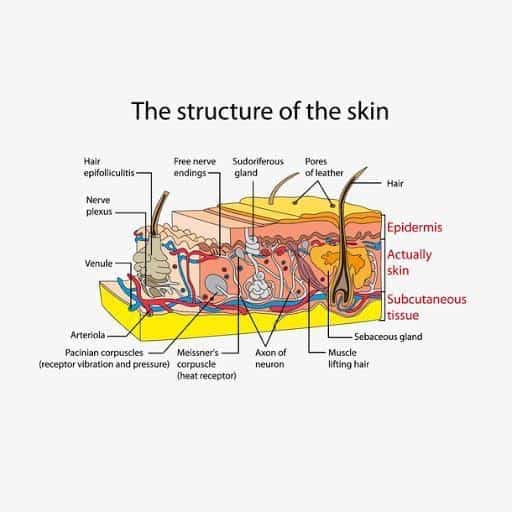The skin is the largest organ in the human body, accounting for about 15% of body weight. The chemical composition of the skin includes 70% water, 25% protein and 2% lipid, as well as trace elements, nucleic acids, glycosaminoglycans, proteoglycans, and a large number of other chemicals.
The structure of the skin is basically divided into three layers: epidermis, dermis, and subcutaneous tissue. The epidermis can be divided into five layers in the form of cells: cuticle, transparent layer, granular layer, spinous layer, and basal layer.
1. Basal layer
Located in the deepest part of the epidermis, arranged in a fence, only one layer of cells can divide and evolve slowly. The time required for 1 cell to split into 2 cells is 19 days. When damaged, the basal layer cells will grow and repair without leaving scars on the skin.
2. Thorn layer
Together with the base layer is called the growth zone, also known as the seed layer. It is composed of 4-8 layers of polygonal cells with spines, and the spinous processes of the cells are particularly obvious. It is the thickest layer in the epidermis. It can continuously produce new cells, so that the layers go up and have cell division (the ability to multiply). There is a gap between cells to store lymph fluid to supply cell nutrition.
3. Particle layer
It is composed of 2 to 4 layers of diamond-shaped cells. The nucleus is very pale and has keratin particles. It is clearly distributed in the palm and toe and other parts. It has a blocking effect on light reflection. It can prevent foreign bodies from invading.
4. Transparent layer
It is composed of 2 to 3 layers of flat non-nucleated cells, which can control the moisture of the skin and prevent the loss of water. The cells begin to age and shrink in this layer. This layer can only be found in the thick cuticles such as the palm and sole of the foot. It is colourless and transparent, and light can pass through.
5. Cuticle
It is the outermost layer of the epidermis, consisting of 4 to 8 layers of extremely flat and non-nucleated keratinocytes, containing keratin and keratinous fat, it is without blood vessels and nerves. The keratinocytes in the outer layer will fall off by themselves after a certain period of time, and there will be newly formed keratinocytes to supplement it. The stratum corneum can best express whether the skin is toned and elastic. And it has anti-friction and prevents the penetration of tissue fluid in the body. It can also prevent the invasion of chemicals and bacteria in the surrounding. Its regeneration ability is extremely strong. Keratinocytes contain moisturizing factors, which can prevent the evaporation of surface water and have strong water absorption.
There are five types of normal skin: dry, oily, mixed, sensitive, and neutral.
~ For example, oily skin is prone to excessive cleansing, while dry and neutral or mixed types are prone to insufficient moisturization
~ The type of skin is not static, it changes at any time according to factors such as age, season, region and other factors. This is why some people’s skin conditions are mixed or oily in summer and dry in winter.
~ From personal experience, if the skin presents more than one problem, the order of conditioning is:
A. Restore the normal physiological function of the skin: restore water and oil secretion-repair sebum film
B. Inflammation treatment: allergies, severe acne
C. Repair and reconstruction: cuticle repair, pore repair, basal cell maintenance, and reconstruction of metabolism
D. Accelerate metabolism: skin tone adjustment, pigment metabolism
E. Anti-aging: wrinkles, sagging, contour adjustment
~ In general, if you understand the level of the skin, you should carry out detailed skin management according to the different conditions of the skin. The so-called meticulousness is not about the more steps, the better, but the tailor-made, tailored to the local conditions, adjust the skin care steps according to the changes of seasons, climate, and skin conditions, and select the appropriate products, such as:
1. Everyday skin care products that you are most exposed to, because of the existence of the skin barrier function, in fact, the core role of skin care products is the epidermal layer, the more obvious the surface layer, such as the cuticle.
The deeper the layer, the smaller the effect. Basically, the limit of the force is the basal layer of the skin epidermis. Only a very small number of ultrafine molecules and certain special ingredients can reach the dermal layer to enter the blood circulation, such as unilateral essential oil, but the force is not large, The amount that can be entered is also very small. This means that the problems that can be solved by simply applying topical skin care products are mainly concentrated on the epidermal layer, especially the stratum corneum, and the deeper the skin problem occurs, the weaker the skin care product’s effect. For example, the skin surface is dry and dehydrated, and skin care products are easy to solve quickly. But if the skin is loose and wrinkled due to the loss of deep collagen in the skin, it is very difficult to solve by skin care products alone.
2. At this time, we have to rely on other methods besides skin care products.
~ Skin massage, small face massage, manipulative stimulation stimulate deeper tissues below the epidermis
So no matter what method is used for skin care, to protect the normal physiological structure and physiological function of the skin.
And to protect the skin’s sebum film, but also to protect the stratum corneum of the skin, and every layer of the skin.
Protection is the best skin care.


